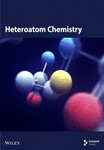Synthesis and characterization of new blue-greenish electroluminescent materials based on 1,3,4-oxadiazole-triazolopyridinone hybrids
Ming-Hsiang Shin
Department of Chemistry, National Cheng Kung University, No 1, Ta Hsueh Rd., Tainan, Taiwan 70101, Republic of China
Search for more papers by this authorCorresponding Author
Fung Fuh Wong
Graduate Institute of Pharmaceutical Chemistry, China Medical University, No. 91, Hsueh-Shih Rd., Taichung, Taiwan 40402, Republic of China
Graduate Institute of Pharmaceutical Chemistry, China Medical University, No. 91, Hsueh-Shih Rd., Taichung, Taiwan 40402, Republic of ChinaSearch for more papers by this authorChun-Min Lin
Department of Chemistry, National Cheng Kung University, No 1, Ta Hsueh Rd., Tainan, Taiwan 70101, Republic of China
Search for more papers by this authorWen-Yi Chen
Department of Chemistry, National Cheng Kung University, No 1, Ta Hsueh Rd., Tainan, Taiwan 70101, Republic of China
Search for more papers by this authorMou-Yung Yeh
Department of Chemistry, National Cheng Kung University, No 1, Ta Hsueh Rd., Tainan, Taiwan 70101, Republic of China
Nan Jeon Institute of Technology, No.178, Chaocin Rd., Yanshuei Township, Tainan County Taiwan 737, Republic of China
Search for more papers by this authorMing-Hsiang Shin
Department of Chemistry, National Cheng Kung University, No 1, Ta Hsueh Rd., Tainan, Taiwan 70101, Republic of China
Search for more papers by this authorCorresponding Author
Fung Fuh Wong
Graduate Institute of Pharmaceutical Chemistry, China Medical University, No. 91, Hsueh-Shih Rd., Taichung, Taiwan 40402, Republic of China
Graduate Institute of Pharmaceutical Chemistry, China Medical University, No. 91, Hsueh-Shih Rd., Taichung, Taiwan 40402, Republic of ChinaSearch for more papers by this authorChun-Min Lin
Department of Chemistry, National Cheng Kung University, No 1, Ta Hsueh Rd., Tainan, Taiwan 70101, Republic of China
Search for more papers by this authorWen-Yi Chen
Department of Chemistry, National Cheng Kung University, No 1, Ta Hsueh Rd., Tainan, Taiwan 70101, Republic of China
Search for more papers by this authorMou-Yung Yeh
Department of Chemistry, National Cheng Kung University, No 1, Ta Hsueh Rd., Tainan, Taiwan 70101, Republic of China
Nan Jeon Institute of Technology, No.178, Chaocin Rd., Yanshuei Township, Tainan County Taiwan 737, Republic of China
Search for more papers by this authorAbstract
New functionalized oxadiazole-triazolopyridinone derivatives were synthesized via arcycloaddition. With the chromophores of triazolopyridinone, the photoluminescence spectra of these compounds in dichloromethane solution showed emission peaks between 430 and 520 nm. Following the spectroscopic studies, and the measurements of cyclic voltammogram, 1,3,4-oxadiazole-triazolopyridinone hybrids possess a great potential as highly efficient, blue-greenish, organic light-emitting devices materials. © 2007 Wiley Periodicals, Inc. Heteroatom Chem 18:212–219, 2007; Published online in Wiley InterScience (www.interscience.wiley.com). DOI 10.1002/hc.20285
REFERENCES
- 1 Tang, C. W.; Van Slyke, S. A. Appl Phys Lett 1987, 51, 913.
- 2 Tang, C. W.; Van Slyke, S. A.; Chen, C. H. J Appl Phys 1989, 65, 3610.
- 3 Steuber, F.; Staudigel, J.; Stössel, M.; Simmerer, J.; Winnacker, A.; Spreitzer, H.; Weissörtel, F.; Salbeck, J. Adv Mater 2000, 12, 130.
- 4 Wu, C.-C.; Lin, Y.-T.; Wong, K.-T.; Chen, R.-T.; Chien, Y.-Y. Adv Mater 2004, 16, 61.
- 5(a) Shi, J.; Tang, C. W. Appl Phys Lett 2002, 80, 3201; (b) Wu, C.-C.; Lin, Y.-T.; Chiang, H.-H.; Cho, T.-Y.; Chen, C.-W.; Wong, K.-T.; Liao, Y.-L.; Lee, G.-H.; Peng, S.-M. Appl Phys Lett 2002, 81, 577.
- 6(a) Li, Y.; Fung, M. K.; Xie, Z.; Lee, S.-T.; Hung, L.-S.; Shi, J. Adv Mater 2002, 14, 1317; (b) Shih, H.-T.; Lin, C.-H.; Shih, H.-H.; Cheng, C.-H. Adv Mater 2002, 14, 1409.
- 7(a) Kim, Y.-H.; Shin, D.-C.; Kim, S.-H.; Ko, C.-H.; Yu, H.-S.; Chae, Y.-S.; Kwon, S.-K. Adv Mater 2001, 13, 1690; (b) Chan, L.-H.; Yeh, H.-C.; Chen, C.-T. Adv Mater 2001, 13, 1637.
- 8(a) Adachi, C.; Tsutsui, T.; Saito, S. Appl Phys Lett 1990, 56, 799; (b) Adachi, C.; Tsutsui, T.; Saito, S. Appl Phys Lett 1990, 57, 513.
- 9 Hughes, G.; Bryce, M. R. J Mater Chem 2005, 15, 95.
- 10 Adachi, C.; Tsutsui, T.; Saito, S. Appl Phys Chem 1990, 56, 799.
- 11 Wang, C.; Jung, G..-Y.; Batsanov, A. S.; Bryce, M. R.; Petty, M. C. J Mater Chem 2002, 12, 173.
- 12 Guan, M.; Bian, Z. Q.; Zhou, F. Y.; Li, Z. J.; Haung, C. H. Chem Commun 2003, 2708.
- 13 Chien, Y.; Wong, K.; Chou, P.; Cheng, Y. Chem Commun 2002, 2874.
- 14 Giannangeli, M.; Cazzolla, N.; Luparini, M. R.; Magnani, M.; Mabilia, M.; Picconi, G.; Tomaselli, M.; Baiocchi, L. J Med Chem 1999, 42, 336.
- 15 Fox, H. H.; Gibas, J. T. J Org Chem 1953, 18, 1375.
- 16 Wang, C.; Jung, G.-Y.; Hua, Y.; Pearson, C.; Bryce, M. R.; Petty, M. C.; Batsanov, A. S.; Goeta, A. R.; Howard, J. A. Chem Mater 2001, 13, 1167.
- 17 Kuo, C. U.; Wu, M. H.; Chen, S. P.; Li, T. P.; Huang, C. Y.; Yeh, M. Y. J Chin Chem Soc 1994, 41, 849.
- 18 Demas, J. N.; Crosby, G. A. J Phys Chem 1971, 75, 991.
- 19 Thelakkat, M.; Schmidt, H.-W. Adv Mater 1998, 10, 219.
- 20 Wu, F.-I.; Shu, C.-F.; Chien, C.-H.; Tao, Y.-T. Synth Met 2005, 148, 133.
- 21 Chiu, C.-Y.; Kuo, C.-N.; Kuo, W.-F.; Yeh, M.-Y. J Chin Chem Soc 2002, 49, 239.




